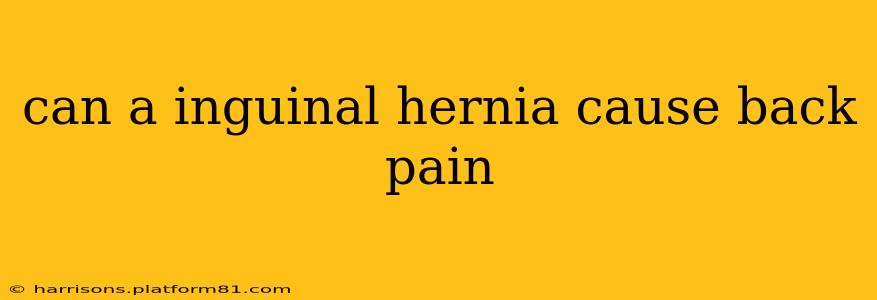An inguinal hernia, a protrusion of tissue through a weakness in the abdominal wall near the groin, is often associated with groin pain. However, it can sometimes cause pain in seemingly unrelated areas, including the back. This isn't a direct cause-and-effect relationship in most cases, but rather an indirect connection stemming from the hernia's impact on the body's mechanics and nervous system. Let's delve into the potential links between inguinal hernias and back pain.
How Can an Inguinal Hernia Lead to Back Pain?
The relationship between an inguinal hernia and back pain isn't straightforward. While a hernia itself doesn't directly cause back pain, the consequences of the hernia can. Here's how:
-
Muscle Strain and Compensation: The presence of a hernia can lead to muscle strain in the abdominal and pelvic region. To compensate for the weakness and discomfort in the groin, individuals may unconsciously alter their posture and gait. This altered posture can strain the back muscles, leading to pain. Think of it like a chain reaction – the groin pain triggers compensatory movements that overload the back.
-
Nerve Irritation: While rare, the hernia could potentially irritate nerves in the area. This nerve irritation might manifest as referred pain, which means pain is felt in a location different from the source. The nerves in the groin area share pathways with those supplying the lower back, so pain from the hernia could be felt in the back.
-
Increased Abdominal Pressure: A large or strangulated hernia can increase the overall pressure within the abdomen. This increased pressure can affect the spine and surrounding muscles, potentially contributing to back pain.
-
Indirect Effects: Chronic pain from the hernia, especially if untreated, can lead to stress and muscle tension, which can further exacerbate back pain.
Can a Hernia in the Right Groin Cause Left Back Pain?
While pain is often felt on the same side as the hernia, referred pain can cause symptoms to appear on the opposite side of the body. This is because nerves can branch and connect to different areas. So, yes, a right groin hernia could potentially cause left back pain due to this phenomenon of referred pain. However, it's less common than pain on the same side.
What Other Symptoms Might Accompany an Inguinal Hernia?
Beyond back pain, several other symptoms can point to an inguinal hernia:
- Groin Pain: This is the most common symptom, often described as a dull ache or sharp pain, particularly when coughing, sneezing, or straining.
- Bulge or Lump in the Groin: A visible or palpable bulge in the groin area, especially when standing or straining, is a hallmark sign.
- Pain Radiating to the Scrotum or Testicle: In men, pain may radiate down into the scrotum or testicle.
- Nausea or Vomiting (in severe cases): If the hernia becomes strangulated (the blood supply is cut off), this can lead to serious complications requiring immediate medical attention.
When Should I See a Doctor About Groin or Back Pain?
If you experience groin pain accompanied by back pain, or notice a bulge in your groin, consult a doctor promptly. Early diagnosis and treatment of an inguinal hernia are crucial to prevent complications. A physical exam and potentially imaging tests (like an ultrasound) will help confirm the diagnosis.
How Is an Inguinal Hernia Treated?
Treatment options for inguinal hernias vary depending on the severity of the hernia and the patient's overall health. Options include:
- Observation: In some cases, especially for small, asymptomatic hernias, a doctor may recommend watchful waiting.
- Surgery: This is often the recommended treatment for symptomatic hernias or those that are growing larger. Surgical repair can either be open or laparoscopic (minimally invasive).
This information is for educational purposes only and should not be considered medical advice. Always consult with a healthcare professional for any health concerns or before making any decisions related to your health or treatment.
